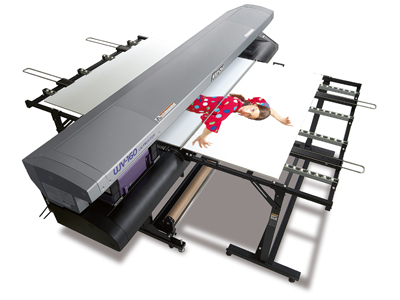Low cost hybrid wide format UV printers can print on anything, roll or sheet. Simon Eccles asks if these are the ideal machines for newcomers?
Thinking of branching out into wide format but not sure where the market is going to lead you? It is worth considering one of the low cost hybrid UV models that can accept both rigid sheets and roll-fed flexible media. With prices in the £27,000 to £50,000 range and the ability to print on practically anything, they are a low-risk way of dipping a toe into the wide format market.
At present EFI, Mimaki, Mutoh and Roland DG all offer hybrid UV printers in this price bracket. In the late 2000s Agfa was in this market too with the low end of its Anapurna M-series which started at about £60,000 for the M4, but it is now moved upmarket and its lowest priced hybrid is the M2050 at abut £117,000.
‘Hybrids are a stepping stone to a full flatbed, said Mark Elvidge at Roland DG. Many customers aspire to run a flatbed and get the occasional request for rigid work, but not enough to justify the investment cost of a full flatbed. Rather than turn the work away or farm it out, a hybrid allows those customers to invest in a printer that can do the rigid work and allow the business to grow the demand for prints that would justify the investment of a full flatbed.
These printers all have their origins as converted roll-feed models, so they are pretty good at that to start with. It is the rigid sheet handling where there may be a compromise, particularly when it comes to total sheet thickness and precision positioning. They have add-on roller frameworks fore and after to support the sheets as they go under the print heads. The frames are often built as wheeled trolleys so they can be removed and wheeled away when they are not needed.
Mr Elvidge spells this out: ‘When it comes to choosing a machine, for many businesses versatility is key – and a hybrid machine can offer this. This is especially true when the bulk usage of the machine will be roll-to-roll, but printing rigid media needs to be an option. In roll-to-roll ‘mode’ a hybrid takes up the same floor space as a standard wide format printer, further increasing its desirability.’
Purpose-built flatbed printers normally have a much more sturdy bed, either fixed or moving under the head unit, often with greater provision to raise or lower the heads to accommodate different media thicknesses. Mr Elvidge points out that hybrids can still be very versatile; for instance: ‘It is possible to print onto 3D objects such as phone cases with the aid of a carrier jig – our VersaUV LEJ-640 has the ability to print with white and gloss inks, onto media up to 13 mm thick, covering the major board groups easily.’
The LEJ-640 costs £46,999 and takes roll or sheet media up to 1.635 metres wide. It offers a choice of CMYK + White + Clear inks, or CMYK with either double white or double clear.
Mutoh has the lowest cost hybrids on the market (not counting the inevitable Chinese imports). It has two models, one of which uses Mutoh’s CMYK + White corn-based solvent ink, which is a bit of a gamble compared with UV. This 1.62 metre printer, the ValueJet 1617H, costs £27,995 from UK distributor Colourgen. For the same price there is a more conventional UV ink model, the 1626UH LED, with CMYK plus optional white and clear inks, 1.65 metre print width and LED curing. Both are pretty slow though.
Mimaki is also in this market with the £36,995 UVJ-160, a 1.6 metre UV printer with both roll feed and foldaway feed/support tables for rigid sheets up to 10 mm thick. It can print hard or flexible UV inks and in CMYKlclm colours + white.
EFI’s entry level hybrid UV offering is the H652, a 1.65 m wide model that can handle media up to 46 mm thick (and weighing up to 34 kg, so it will take glass and Dibond). Its vacuum belt transports both the rigid and roll media. The price is approximately £50,000. However Simon Casajuana, UK southern territory sales manager, says that commercial printers moving into wide format are just as likely to chose the more sophisticated H1625 LED. This has higher throughput, variable droplet sizes, white ink and highly efficient LED curing lamps, but it costs twice as much.
‘If you are an existing wide format user with roll to roll, then you are likely to choose another roll fed printer,’ Mr Casajuana says. ‘But if you don’t yet know where your business will go, or the substrates you’ll use, then it is clever to go for both. A hybrid printer handles everything and you don’t need to commit yourself from the start. You can see how your sales develop.’





